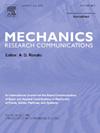纤维超材料的新铰链设计使长丝3D打印成为可能
IF 2.3
4区 工程技术
Q3 MECHANICS
引用次数: 0
摘要
纤维超材料具有显著的力学性能。在他们的实验研究中,经常使用增材制造。当试图通过3D打印制作样品进行测试时,面临的主要问题在于实现连接纤维的元件。这已经通过选择性激光烧结(SLS)技术实现,但似乎很难用其他印刷技术来实现,比如基于长丝的技术。在这项工作中,我们展示了在被称为受电弓超材料的特殊纤维超材料的框架内,一种专门针对基于长丝的3D打印优化的连接铰链的新设计。这是SLS的第一个基本优势:长丝印刷非常便宜,现在每个人都可以使用。此外,这种铰链设计可以在纤维超材料结构中实现更快的原型制作,更广泛的定制和更高的可靠性。本文章由计算机程序翻译,如有差异,请以英文原文为准。
New hinge design for fibrous metamaterial enables for filament 3D printing
Fibrous metamaterials exhibit remarkable mechanical properties. For their experimental study, additive fabrication is frequently employed. The main problem one faces, when trying to produce by 3D printing a specimen to test, lies in the realization of elements connecting the fibers. This has been achieved using selective laser sintering (SLS) techniques, but appears to be very hard to perform with other printing techniques, like the filament-based one. In this work, we show, within the framework of the particular class of fibrous metamaterials known as pantographic metamaterials, a novel design for connecting hinges specifically optimized for filament-based 3D printing. This has a first fundamental advantage with respect to SLS: filament printing is extremely cheaper and can be accessible nowadays to everybody. Moreover, this hinge design enables faster prototyping, broader customization, and greater reliability in fibrous metamaterial structures.
求助全文
通过发布文献求助,成功后即可免费获取论文全文。
去求助
来源期刊
CiteScore
4.10
自引率
4.20%
发文量
114
审稿时长
9 months
期刊介绍:
Mechanics Research Communications publishes, as rapidly as possible, peer-reviewed manuscripts of high standards but restricted length. It aims to provide:
• a fast means of communication
• an exchange of ideas among workers in mechanics
• an effective method of bringing new results quickly to the public
• an informal vehicle for the discussion
• of ideas that may still be in the formative stages
The field of Mechanics will be understood to encompass the behavior of continua, fluids, solids, particles and their mixtures. Submissions must contain a strong, novel contribution to the field of mechanics, and ideally should be focused on current issues in the field involving theoretical, experimental and/or applied research, preferably within the broad expertise encompassed by the Board of Associate Editors. Deviations from these areas should be discussed in advance with the Editor-in-Chief.

 求助内容:
求助内容: 应助结果提醒方式:
应助结果提醒方式:


